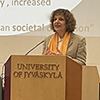The next seminar in the Geoscience Seminar Series will be held on Tuesday 28 March from 15:15 to 16:30 in Room 401, Mathematics and Physics Building.
There will be two presentations dealing with Air Quality and Climate Modelling, given by Mr William Hicklin and Dr James Ciarlo`. Mr William Hicklin is a Research Support Officer at the Department of Geosciences. Dr James Ciarlo` has recently successfully defended his Ph.D. thesis at the Department of Geosciences. Refreshments will be provided after the talks.
Collection, validation and maintenance of air quality data
- William Hicklin
The Mobile Air Quality Laboratory and the Giordan Lighthouse GAW station generate a considerable amount of air quality data. The maintenance, servicing and calibration of the equipment used, as well as the processing and validation of the collected data are extensive and time-consuming tasks. An online system, designed to automate and facilitate most of these processes, has been under development. The main target is to reduce mind-numbing tasks to be carried out by the researcher, allowing more time for data analyses and research, while ensuring consistent and reliable data collection. The concept ideas and working principles of this data management system will be exposed and further discussed.
Modelling the Formation and Radiative Effects of Secondary Organic Aerosols in a Climate Model
- James Ciarlo`
Aerosols are known to cause changes in temperature and precipitation as a result of their effect on radiation and cloud droplets, and hence have a strong influence on the climate. Organic aerosols that form via the chemical oxidation of a gaseous precursor are called Secondary Organic Aerosols (SOAs). The organic nature of these aerosols results in very different optical properties than other aerosols. Most climate models do not take into account SOAs or their radiative properties, however, recent studies have started including small suites of SOAs in order to reduce model biases. A recent gas phase module, the CB6r2, was coupled with RegCM4 to obtain a more holistic suite of Volatile Organic Compounds (VOCs) and chemical mechanisms, most notably ethyne, benzene, and pinene and their corresponding oxidation products. These gas phase products were coupled to Secondary Organic Aerosol Model (SORGAM) to produce the SOAs in the Regional Climate Model, RegCM4. The resulting aerosols were aggregated into categories in order to group the optical properties. With rigorous testing and optimisation, the addition of SOAs and their radiative properties may provide the means to reduce model biases, and produce more reliable climate simulations.


